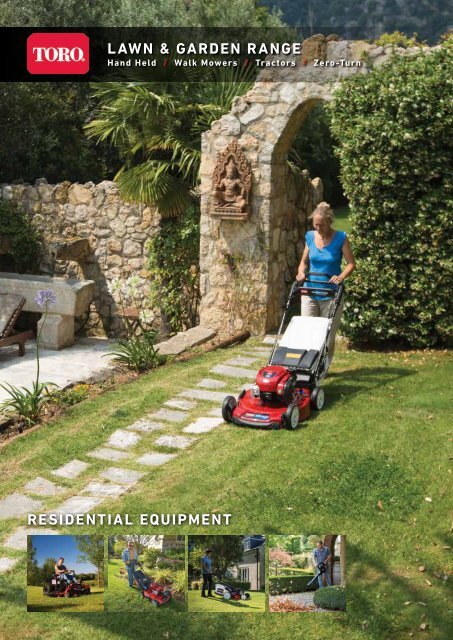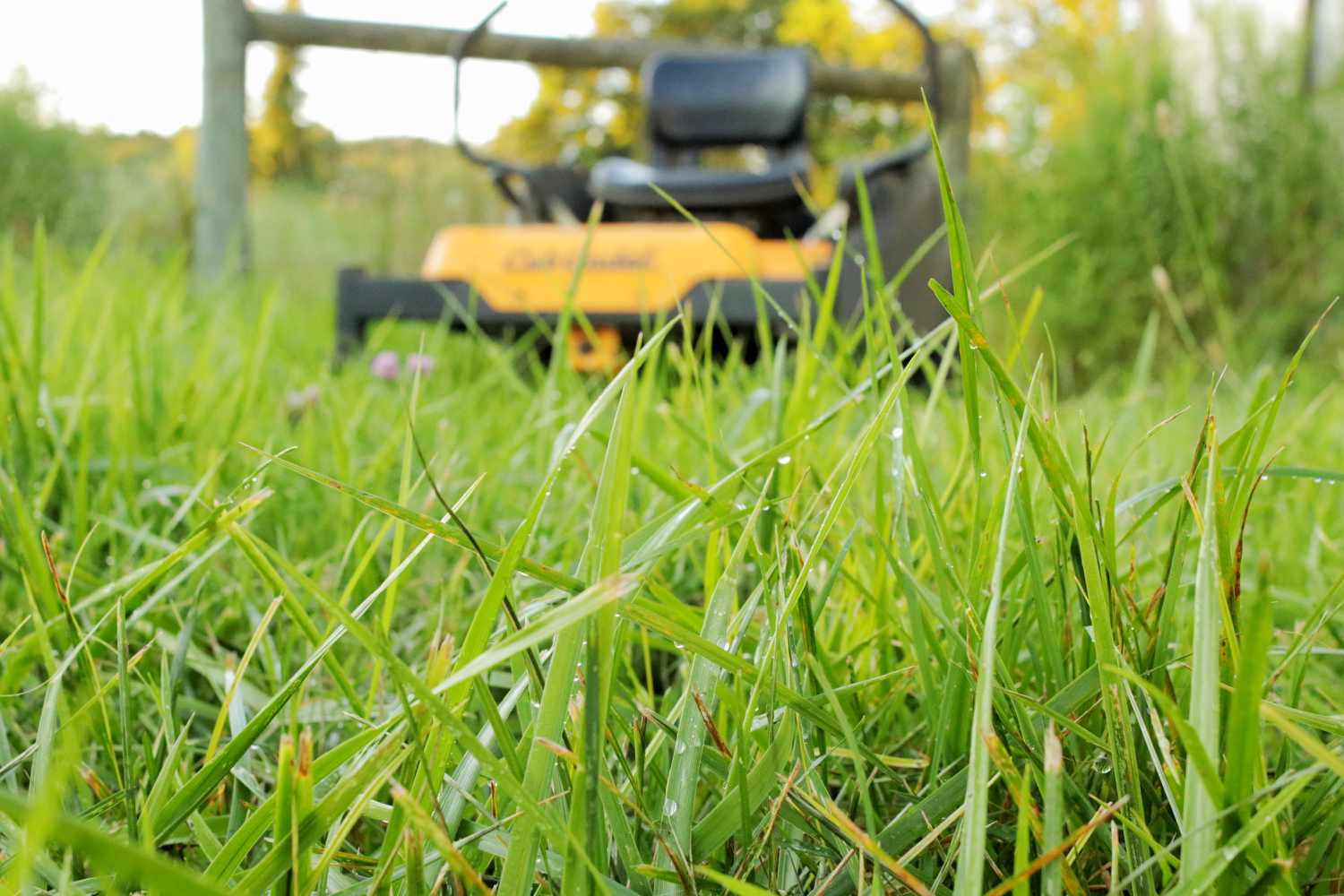Yes, you can cut wet grass with a battery mower, but it’s not recommended. Doing so may reduce the mower’s effectiveness and potentially damage its components.
For homeowners and gardening enthusiasts, maintaining a neat lawn is a task often at the mercy of the weather. Cutting grass with a battery-powered mower offers the convenience of cordless operation and less noise compared to gas mowers. While these mowers have advanced in power and efficiency, mowing wet grass poses challenges such as clumping, uneven cuts, and additional strain on the mower’s battery and blades.
Moreover, wet conditions raise safety concerns due to potential slipping or the risk of electric shock. Despite these issues, some users may find themselves needing to trim slightly damp lawns due to persistent wet weather, though heavy moisture is a definite no-go for any mower. Care must be taken to ensure the longevity of the equipment and a well-manicured lawn.

Credit: www.yumpu.com
Understanding The Impact Of Wet Grass On Mowing Performance
Mowing a lawn is a routine part of garden maintenance, but the task can become considerably trickier post-rainfall or early morning dew. Wet grass affects mowing performance in several notable ways. Grasping the nuances of how moisture alters your mowing experience will guide you in using a battery mower optimally, preserving both your lawn’s health and the mower’s longevity.
Increased Resistance And Clumping
Wet grass poses a unique challenge due to the increased resistance and propensity for clumping. These issues stem from the blades of grass sticking together and becoming heavier when wet, which can lead to uneven cuts and patches. This resistance also means your battery mower’s motor must work harder, which could reduce its efficiency and battery life. Key factors include:
- Blades traction: Wet grass can cause less traction for the mower’s blades, leading to skidding or the mower getting stuck.
- Clumps formation: Clumps of wet grass may form and not only look unsightly but can also smother the grass beneath, hindering growth.
- Deck clogging: The accumulation of wet clippings under the mower’s deck requires frequent stops to clean, thus lengthening the mowing task.
Potential Damage To Mower Components
When tackling a damp lawn, the risk of potential damage to mower components escalates. Moisture can be a formidable enemy of any machinery, and a battery mower is no exception. Notable impact areas include:
| Component | Impact |
|---|---|
| Battery and electrical systems | Higher risk of short circuits or corrosion, which can compromise mower functionality and safety. |
| Metal parts | Increased exposure to moisture can accelerate rusting and deterioration of metal components. |
| Vents and filters | Wet grass and debris can clog vents and filters, affecting airflow and mower performance. |
By taking these factors into account, you can decide the optimal mowing conditions and protect your equipment. While modern battery mowers are designed with some level of moisture resistance, it’s crucial to carefully consider the condition of your lawn before proceeding with mowing in wet conditions.
Debunking The Myth Of Ineffective Cutting
The familiar scene of waiting for the perfect sunny day to mow your lawn might soon be a chapter from the past. Many homeowners believe that wet grass spells disaster for mowing tasks, especially with a battery mower. The prevailing myth that battery mowers can’t handle the dampness has dissuaded many from even attempting the feat. But this is the age of technology, where innovations relentlessly shatter old limitations. In this discussion, we’ll explore how modern advancements allow for effective grass cutting in moist conditions, and provide actionable expert tips for those ready to maintain their lush lawns rain or shine.
Advancements in Battery Mower TechnologyAdvancements In Battery Mower Technology
The evolution of battery-powered lawn mowers has been nothing short of remarkable. Today’s models boast impressive features that ensure efficiency and durability, even in wet conditions.
- Enhanced Battery Life: Early battery mowers often fell short on power and endurance. The latest iterations, however, come equipped with long-lasting lithium-ion batteries – a significant step up that guarantees the completion of your lawn chores without interruption.
- Higher Torque Motors: Modern mowers have motors designed to handle heavy loads. Increased torque means that even wet, dense grass can be sliced through with relative ease.
- Weather-Resistant Construction: Manufacturers now consider moisture resistance crucial in design, leading to mowers that can withstand damp grass without succumbing to corrosion or water damage.
Expert Tips For Optimal Wet Grass Cutting Performance
| Tips | Benefits |
|---|---|
| Blade Sharpness | Maintains clean cuts, reduces clumping |
| Mowing Height Adjustment | Prevents scalping, promotes healthy grass |
| Slow and Steady Pace | Ensures thorough cutting, minimizes jams |
Experienced gardeners recommend taking particular care when mowing in damp conditions. A sharpened blade is vital; it guarantees a clean cut rather than a tear, which can be detrimental to grass health and mower performance. Adjusting the mowing height to a taller setting can help prevent the dreaded lawn scalping, giving your grass the best chance to flourish after a wet trim. Also, adopting a deliberate and measured approach will help manage the added weight and resistance of wet grass, ensuring your battery mower works effectively without overburdening the system.
In summary, the advancements in battery mower technology and adherence to expert tips can lead to exceptional wet grass cutting performance. Gone are the days where rainstorms dictate the mowing schedule. Embrace these practices and watch your lawn maintain its splendor, come drizzle or downpour.
Best Practices For Efficient And Effective Mowing
Welcome to our essential guide on achieving efficient and effective mowing, even when dealing with the tricky situation of wet grass. Cutting wet grass with a battery-powered mower can be challenging, but with the correct approach, it’s entirely possible. Let’s dive into the best practices that will ensure your lawn is beautifully manicured without compromising on the health of your grass or the performance of your mower.
Adjusting Mowing Height And Speed
One of the keys to a successful mow on damp grass is adjusting the height and speed of your battery mower. A higher cut length prevents the mower from becoming bogged down and ensures the grass doesn’t clump as easily. Setting your mower to a higher deck position reduces stress on the battery and motor while providing a cleaner cut.
- Check the manufacturer’s guidelines for the recommended mowing height for your specific model.
- Slow down your mowing speed to allow the mower blades more time to cut effectively and avoid clogging.
Proper Maintenance And Blade Care
Maintenance is crucial to the performance of your battery mower, especially when dealing with wet conditions. Regularly cleaning the undercarriage of your mower and ensuring the blade is sharp and rust-free will help in providing a precise cut and preventing the spread of lawn diseases.
- Clean the mower deck after each use to prevent buildup of grass clippings.
- Sharpen the blades every season, or more frequently if the mower is used heavily.
- Conduct a routine check-up of the battery to ensure it’s holding a charge and functioning optimally.
Dealing With Excessive Moisture And Dampness
Excessive moisture can be a major obstacle for efficient mowing. To handle this challenge:
| Action | Benefit |
|---|---|
| Wait for the optimal time | Ensures the grass isn’t too wet, reducing clumping and making mowing easier. |
| Use a mulching blade if available | Helps in finer cutting of grass and aids in its decomposition. |
| Alternate mowing patterns | Prevents ruts in the lawn and evens out the grass wear patterns for a healthier lawn. |
Avoid mowing right after heavy rainfall or early in the morning when dew is still present on the grass. If the lawn must be mowed, consider using a lawn striper or roller to help remove excess water from the grass surface before mowing.
Understanding The Effects Of Wet Grass On Battery Mower Functionality
Mowing your lawn right after a downpour might not be the best idea, especially if you’re using a battery mower. Wet grass poses unique challenges that can affect both the performance and the longevity of your mower. Let’s delve deeper.
Battery Drainage and EfficiencyBattery Drainage And Efficiency
Mowing on a dry day is tough enough on your battery, but when the grass is wet, the stakes are even higher. The extra energy required to slice through soggy grass can drain your battery faster, reducing the overall mowing time you get on a single charge. This means you’ll be headed back to the charging station sooner than expected.
Cutting efficiency also takes a hit, as wet clippings clump together and stick to the blades and the underside of the mower deck. This additional resistance forces the mower to work harder, which in turn, places greater demand on the battery.
Potential Risks to the Mower’s Electrical ComponentsPotential Risks To The Mower’s Electrical Components
Battery mowers boast the convenience of not having a fuel tank or exhaust emissions, but their electrical components are sensitive to moisture. Introducing these parts to a wet environment can spell trouble.
- Short circuits: Moisture can cause short-circuiting, potentially leading to permanent damage.
- Corrosion: Even if a short circuit is avoided, prolonged exposure to moisture can lead to corrosion of important electrical connections.
- Battery safety: Wet conditions could compromise battery integrity, leading to potential safety hazards.
To sum up, while mowing wet grass with a battery-powered mower is technically possible, it’s fraught with challenges that can impact performance and durability. Always exercise caution and weigh the potential risks before deciding to mow a damp lawn.
Frequently Asked Questions For Can You Cut Wet Grass With A Battery Mower
Is Mowing Wet Grass With A Battery Mower Safe?
Mowing wet grass with a battery mower can pose safety risks. Slippery conditions may cause accidents. Wet clippings can clog the mower, leading to overheating or damage. Always prioritize safety and check your mower’s manual for guidance.
Can Wet Grass Damage A Battery Lawn Mower’s Performance?
Yes, wet grass can affect a battery mower’s performance. It can stick to blades and the undercarriage, causing extra strain on the battery and motor. Mowing dry grass is preferable to preserve your mower’s efficiency.
How Does Moisture Impact Battery Mower Blades?
Moisture can cause battery mower blades to rust over time. It also makes grass blades heavier and more difficult to cut cleanly. Always dry the mower after use to maintain blade condition.
Will Cutting Wet Grass Drain Battery Life Faster?
Cutting wet grass usually demands more power, draining the battery faster. The mower must work harder to cut through the damp, heavy grass, reducing run time. For best battery life, it’s advisable to cut when the grass is dry.
Conclusion
To sum up, trimming wet grass with a battery mower is achievable, though not ideal. Prioritize safety and mower care, and always wait for drier conditions when possible. As we embrace eco-friendly tools like battery mowers, being informed ensures impeccable lawns and enduring equipment alike.
Keep your green spaces thriving with smart mowing practices.
